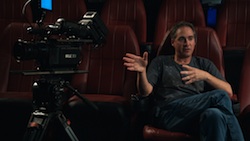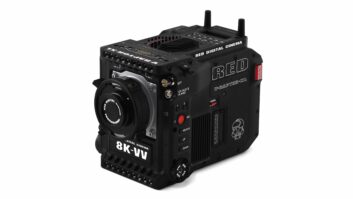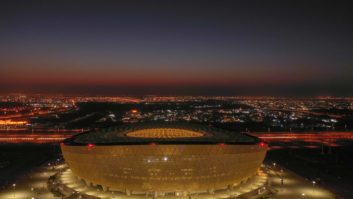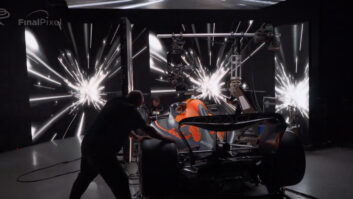
Ted Schilowitz tells Adrian Pennington that the Red rebellion is over.
Few pieces of kit have made as much impact in recent years as the Red One. Its use alone generates headlines, helping to convey a sense of excitement which the company’s carefully guarded, even cryptic, public announcements are designed to cultivate.
Now the firm’s evangelist Ted Schilowitz says he has dropped the self-styled title ‘Leader of the Rebellion’, claiming the war has been won. “The rebellion phase is over. We are all just working to achieve the best imaging system,” he says.
Red Digital Cinema launched the Red One in 2007 with the intent of building a digital movie camera – rather than a video camera — from the ground up. For several months preceding its debut rumours persisted that the technology itself was smoke and mirrors. For some months afterwards there were doubts it would ever ship.
Seasoned industry observers used to gradual increments in technology were sceptical of its claims to deliver a resolution and colour fidelity to rival that of 35mm film, at a fraction of the price. Yet its eventual release blindsided the major manufacturers, Sony and Panasonic, who suddenly found themselves with a serious new competitor.
“We wanted digital cinema to be inclusive not exclusive,” says Schilowitz, whom Red owner Jim Jannard poached from AJA Video, making him employee number one of his new camera company. “The expense of previous systems meant you were making compromises on budget or creativity so we drove in a different direction and a lot of people came along for that ride.”
Between 6000 to 7000 Red Ones, which cost less than £10,000 apiece, have shipped worldwide making the rental market highly competitive. The basic package including a Red supplied 18-50mm lens can be hired for no more than £275 a day. Adding in primes and matte boxes will soon bring the level up to the £800 per day range but there are workarounds.
Schilowitz claims there are now hundreds of productions shooting with Red, daily. TVBEurope spoke to him in the midst of a tour to London, Paris, Amsterdam and Rome where he met Red owners to outline the latest technical developments.
First up is a next generation Super 35mm CMOS sensor, Mysterium-X, which users can have retro-fitted to their existing Red Ones provided they ship them to Red’s California HQ.James Milner-Smyth, CTO of The Post Factory, who owns six bodies, has done just that.
“The new chip is a huge improvement for low-light situations,” he says. “Whereas before we worked at a rated sensitivity of 320ASA and could get at a push to 500ASA before you’d have to do noise reduction, now we can comfortably work at 800ASA and push to 2000ASA.”
He adds, “Nearly all DPs want to have a more natural, less lit style these days and I think this is going to be better than using a very fast film stock. You could light a scene with practical lights and still get very useable pictures.”
Directors David Fincher and Stephen Soderbergh shot their latest projects, The Social Network and The Girlfriend Experience on Reds fitted with the M-X sensor.
Red’s demo features actor Leonardo Di Caprio sitting in an unlit room and lighting a cigar and in the process lighting up his face. “No noise in an unprocessed huge screen at 4K is astonishing,” remarks Milner-Smyth. “And when you do crank up the gain to crazy levels, you struggle to make out any fixed sensor pattern that you’d expect: the noise looks more randomly organic in the same manner as film grain.”
The Mysterium-X is also core to Epic, which in its initial release shortly after NAB will be capable of resolving 5,120 horizontal lines (5K) at 100fps. Later versions, about a year away, will include sensors capable of 6K and 9K. “We believe the industry should be pushing toward 4K distribution end to end from acquisition through to finishing and projection,” says Schilowitz.
Complications in post
A forthcoming Red Ray rack-mount device will play back R3D RAW files natively for on-set use and dailies delivery of 4K rushes. The system also handles up to 12 channels of 24-bit audio. Says Schilowitz, “2K is inadequate for the demands of larger viewing displays in the home and in modern cinema environments where contrary to 30 years ago when the auditoria positioned people away from the screen, the experience is now akin to being in a stadium where people sit up close for full picture immersion.”
If the £19,000 (brain only) Epic-X is aimed at top tier feature film practioners, the sub-$5000 (£3,200) Scarlett with 2/3 inch sensor due for a summer release will deliver 3K. “It’s Epic’s baby brother,” says Schilowitz. “With a set of primes Scarlett is the camera that indie filmmakers have been waiting for to begin to acquire digital cinema quality footage.”
Reds have not been immune to heavy criticism of complications in post stemming from its particular imaging format. In order to record the sheer volumes of 4K information, a lossless compression codec Redcode Raw is used which requires some data wrangling both on-set in the form of digital imaging technicians and in a facility.
“The camera is constantly evolving – it’s intended as an active work in progress and is different to anything that preceded it,” he says. The Red is designed to be modular in hardware (for addition or subtraction of batteries, lenses, recording devices, viewfinders) and software (a series of free firmware upgrades are periodically released).
“I think such flexibility was a major source of confusion,” he admits. “There is so much flexibility in configuring the set up and working with the data that people can overkill a project. You don’t 4K finish for TV. In reality it is incredibly simple to use, much more so than tape or film, since everything is digital. I agree, though, that there is an education process in understanding how file-based workflows can offer extraordinary efficiencies.”
Grading tool Redcine is being replaced by RedCine-X, which Milner-Smyth believes will iron out issues associated with translating RAW footage into HD video colour space. “Now there will only be one setting which is quite filmic, more of a match to what a cinematographer will see on a light metre,” he says. “The big breakthrough though is a hardware card (RedRocket) that can play full quality up to 4K output in real-time. There aren’t many 4K screens and projectors out there right now so we won’t be getting the full benefit of that, but for HD we can now use a Mac as a VTR: have realtime, full quality playback of Red files for less than a tenth the price of an HDCamSR deck.”
Although Red faces competition from Canon’s £1,700 5D Mark II at the bottom end of its market – where the DLSR’s video capture feature is being used to shoot pop promos – both cameras have a growing niche among stills photographers looking to feed the changing dynamics of the print publishing industry.
“There’s a big trend in the stills world towards shooting on Red for combined RAW stills/video, especially for magazine websites,” explains Milner-Smyth. “We’ve been working with a lot of stills photographers and the combination of tools and workflow is a very interesting, and challenging area. Clients expect to be able to deal with moving footage with the same control as a still in Photoshop.”





